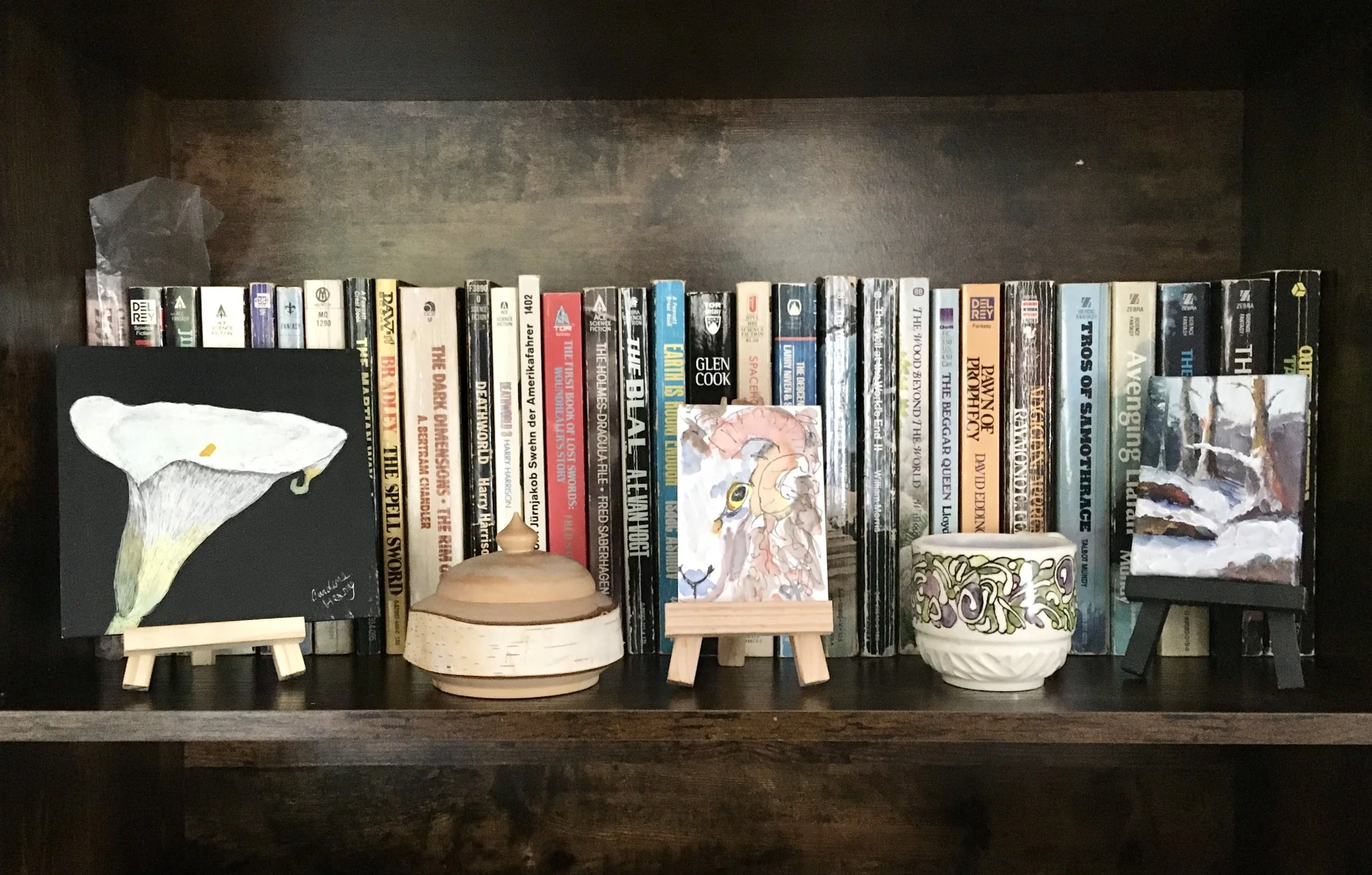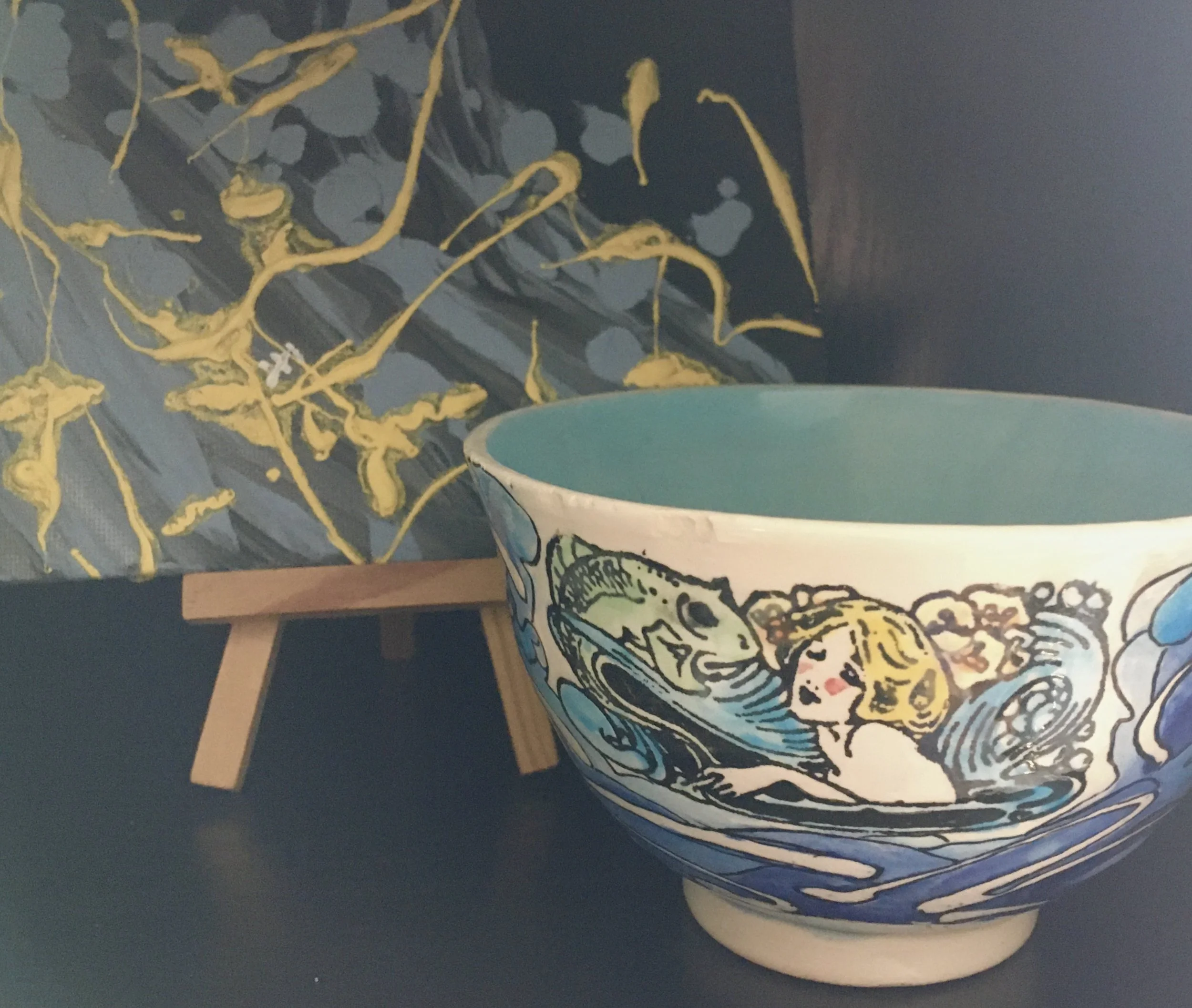The Enormous Pleasure of Small Art
A bookshelf houses a mini art collection, all of which were originally seen at the Lodi Art Center Gallery. Pictured are scratchboard by Caroline Henry, wooden bowl by Glenn Robison, sheep drawing by Ron Ridley, espresso cup by Glenda Burns, and oil painting by Renee Rondon.
Discovering two separately developed pieces of small art seem made for each other is a real delight. The bowl is by Glenda Burns and the abstract painting is by Helen Krummenacker.
Small and miniature art items have been capturing people’s hearts and imaginations for centuries. A visit to the public library or a little online browsing can lead you to the beautiful miniature paintings of ancient India, Persia, and Arabia. In addition, sculptures that would fit into the palm of your hand can be seen in museum exhibits of art and history related to cultures from around the world. In the more recent past, did you know that Samuel F. B. Morse not only invented the telegraph but was also a well-known artist of miniatures as well as larger works?
Like the ancients once did, we are still making and enjoying small art. There is a charm to tiny things. Little wonder that the annual Small Works and Itty Bitty Art Show is a part of the Lodi Community Art Center’s offerings. LCAC and other galleries usually have small works as part of their regular monthly shows as well as featuring them in special shows. In other galleries in nearby communities similar shows will be found. Elk Grove Fine Art Center narrows their year end small works show down to 5 by 7 inch art on wood panels.
Anyone can be an art collector in the world of small art. Both wall space and budget space are easier to find in the 8” by 10” (about 20x25 cm) and under sizes. A smaller size also means more giftable art, for if you find something that perfectly suits a potential recipient’s tastes and interest, you can be confident they will be able to find a spot for it. Small art can be hung solo or in clusters. It can work in companionship with larger art pieces. It can fill a shelf or an entire shelving unit.
Some collectors limit themselves to miniatures. While most speakers use the words small, tiny, and miniature for much the same items, miniature can be defined narrowly in the world of fine art. Among other things, this is art you can hold in the palm of your hand. If you want to focus on the miniature, you will find an interesting history at https://www.artofwildlife.com/miniature_art_history.html . This history includes the formation of societies seeking to elevate the art form and define its elements, such as the Miniature Art Society of Florida and the Miniature Artists of America.
Artist Trading Cards (ATC) and Art Cards, Editions and Originals (ACEO) at 3.5 by 2.5 inches fall into the size range of miniatures but are unique in usually being traded or sold unframed. Collectors place them on tiny easels, in albums, in appropriate-sized file boxes, or other creative displays. Despite the small size, ATCs and ACEOs may not meet the strict definition of miniature in that they may not miniaturize their subject. Something such as an insect, violet blossom, or jewel might be painted larger than life on an ATC rather than reduced in size like a miniature.
From an artist’s viewpoint small art offers its own challenges and opportunities. A few of the advantages are obvious. Small art typically does not require very much workspace, nor does it need much space for storage of supplies or completed art. Small art is easier to transport or ship to shows.
Well-made small art items are apt to result in more frequent sales, and it may be easier to place your art in local gift shops or other retail outlets in addition to galleries.
If an artist finds enormous pleasure in creating art that makes a world of a few square inches of paper or canvas or develops a love of three-dimensional figures or objects that seems to belong to their own Lilliputan world, that artist may specialize in small art for the joy of it alone.
The challenges are much like those of all other art with a couple of extras thrown in. Everything you know about color, value, composition, perspective, line, light and shadow, all of the elements of larger artwork still apply. You will want to stand back and see if the image can draw attention from a distance even though fine detail might call for a close up look. If the finished piece fades into the background from a few feet away, the artist has more work to do.
While creating small has artistic challenges it may have physical ones as well. I’ve known artists who were used to working large, standing and using large arm movements, frequently stepping back to get a proper view in a sort of dance of creation. Along comes a small works show that everyone in their gallery is encouraged to participate in. When they give it a try, it feels like painting with their hands tied!
The same art that may have one person thinking, “It’s lovely how I can do this sitting down, how I can work in this small space, and how easy it is to take my materials with me”, may have another bemoaning the need to sit, the eyestrain on that small focus area, cramped hands from tiny strokes with small tools, and the ease at which a single slip can do so much damage.
When everything comes together well, artists and art lovers can find enormous and lasting pleasure in small and miniature art.


